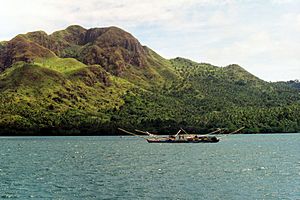Mindanao facts for kids
Mindanao is one of the three main island groups in the Philippines. It is the southernmost large island in the country. Mindanao is special because it has many Muslim people, unlike most of the Philippines. It is located northeast of Sabah.
Mindanao can also refer to the main island within this group.
Contents
Exploring Mindanao: The Southern Philippines
Mindanao is a vibrant and diverse part of the Philippines. It is known for its rich culture, beautiful nature, and unique history. This island group plays an important role in the country's geography and heritage.
Where is Mindanao Located?
Mindanao is found in the southern part of the Philippines. It is surrounded by several seas. To its west is the Sulu Sea, and to its east is the Philippine Sea. The Celebes Sea lies to the south. This location makes Mindanao a key area for trade and travel in Southeast Asia.
The People and Cultures of Mindanao
Mindanao is home to many different groups of people. These include various indigenous communities and a large Muslim population. The Muslim people of Mindanao are often called Moros. They have a rich history and unique traditions. Many Christian Filipinos also live on the island. This mix of cultures makes Mindanao a fascinating place.
Languages Spoken in Mindanao
Because of its diverse population, many languages are spoken in Mindanao. These include Cebuano, Hiligaynon, and various local languages like Maguindanaon and Maranao. Filipino and English are also widely used, especially in schools and businesses.
Mindanao's Amazing Geography
Mindanao has a varied landscape. You can find towering mountains, wide rivers, and beautiful coastlines.
Mountains and Volcanoes
The island is home to Mt. Apo, which is the highest mountain in the Philippines. It is a dormant volcano, meaning it is not active right now. Other mountain ranges also cross the island, creating stunning views and important natural habitats.
Rivers and Lakes
The Rio Grande de Mindanao is one of the longest rivers in the Philippines. It flows through important agricultural areas. There are also several lakes, like Lake Lanao, which is the second largest lake in the country. These bodies of water are important for the local people and wildlife.
A Look at Mindanao's History
Mindanao has a long and interesting history. Before the Spanish arrived, powerful Muslim sultanates existed here. These were independent kingdoms with their own rulers and laws.
Early Kingdoms and Spanish Influence
The Sultanate of Sulu and the Sultanate of Maguindanao were two important Muslim kingdoms. When the Spanish came to the Philippines in the 16th century, they tried to control Mindanao. However, the Muslim people strongly resisted. This led to many conflicts over several centuries.
American Rule and Modern Times
After the Spanish-American War, the United States took control of the Philippines. Mindanao continued to be a place of cultural and political importance. In modern times, efforts have been made to bring peace and development to the region.
Economy and Important Cities
Mindanao is an important agricultural region for the Philippines. It produces many crops and goods.
What Mindanao Produces
The island is known for growing crops like pineapples, bananas, and corn. It also has rich natural resources. Fishing is another important industry along its coasts.
Major Cities in Mindanao
Davao City is the largest city in Mindanao and a major economic hub. It is known for its beautiful parks and festivals. Cagayan de Oro is another important city, often called the "City of Golden Friendship." These cities are centers for trade, education, and culture.
Festivals and Celebrations
Mindanao is famous for its colorful festivals. These events showcase the rich traditions and joyful spirit of the people.
Kadayawan Festival
One of the most famous festivals is the Kadayawan Festival in Davao City. It is a celebration of thanksgiving for a bountiful harvest and the diverse cultures of Mindanao. People enjoy street dancing, parades, and cultural shows.
Images for kids
-
Approximate historical extent of the Muslim sultanates of Sulu, Maguindanao and Lanao in the 19th century
-
Christian Filipinos, who served under the Spanish Army, searching for Moro people during a historical conflict, c. 1887.
-
Two Spanish missionaries baptizing a Moro convert to Roman Catholicism, circa 1890.
-
Cagayan de Oro skyline in 2018
-
Mountains in the province of Bukidnon
-
"I-indak sa kadalanan" or the Street dancing competition, part of Kadayawan Festival celebration in Davao City.
-
Davao City's Chinatown
See also
 In Spanish: Mindanao para niños
In Spanish: Mindanao para niños














